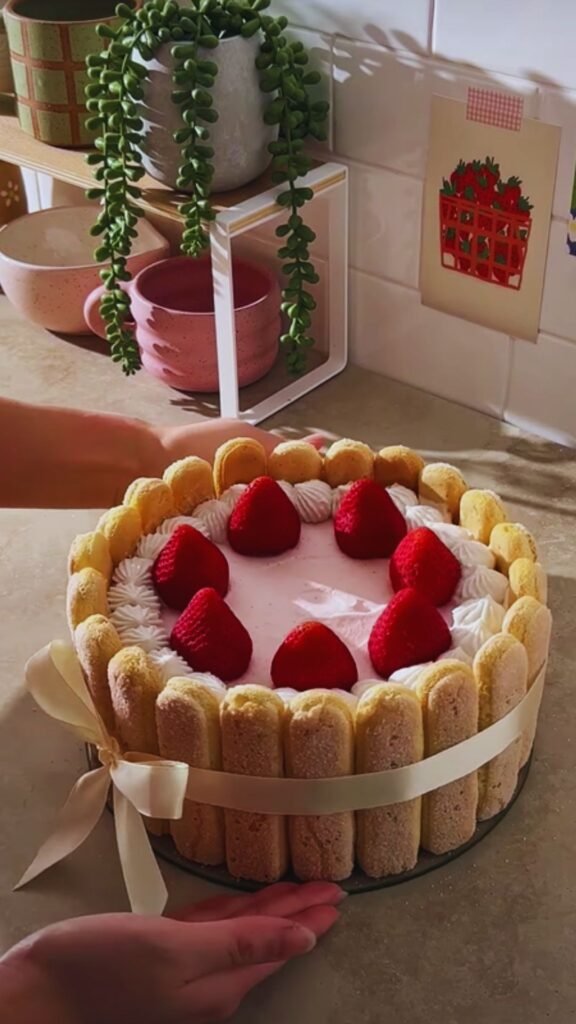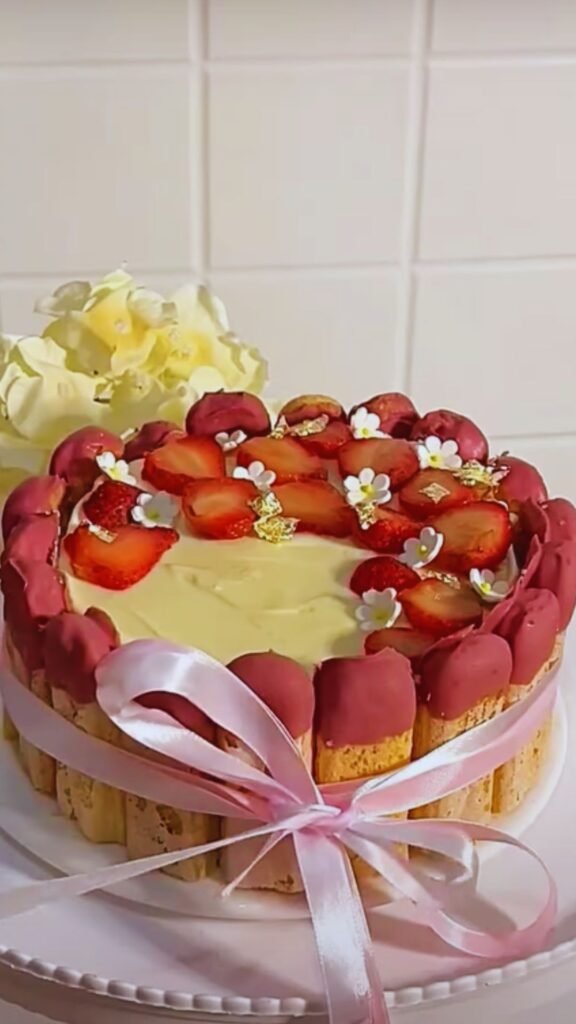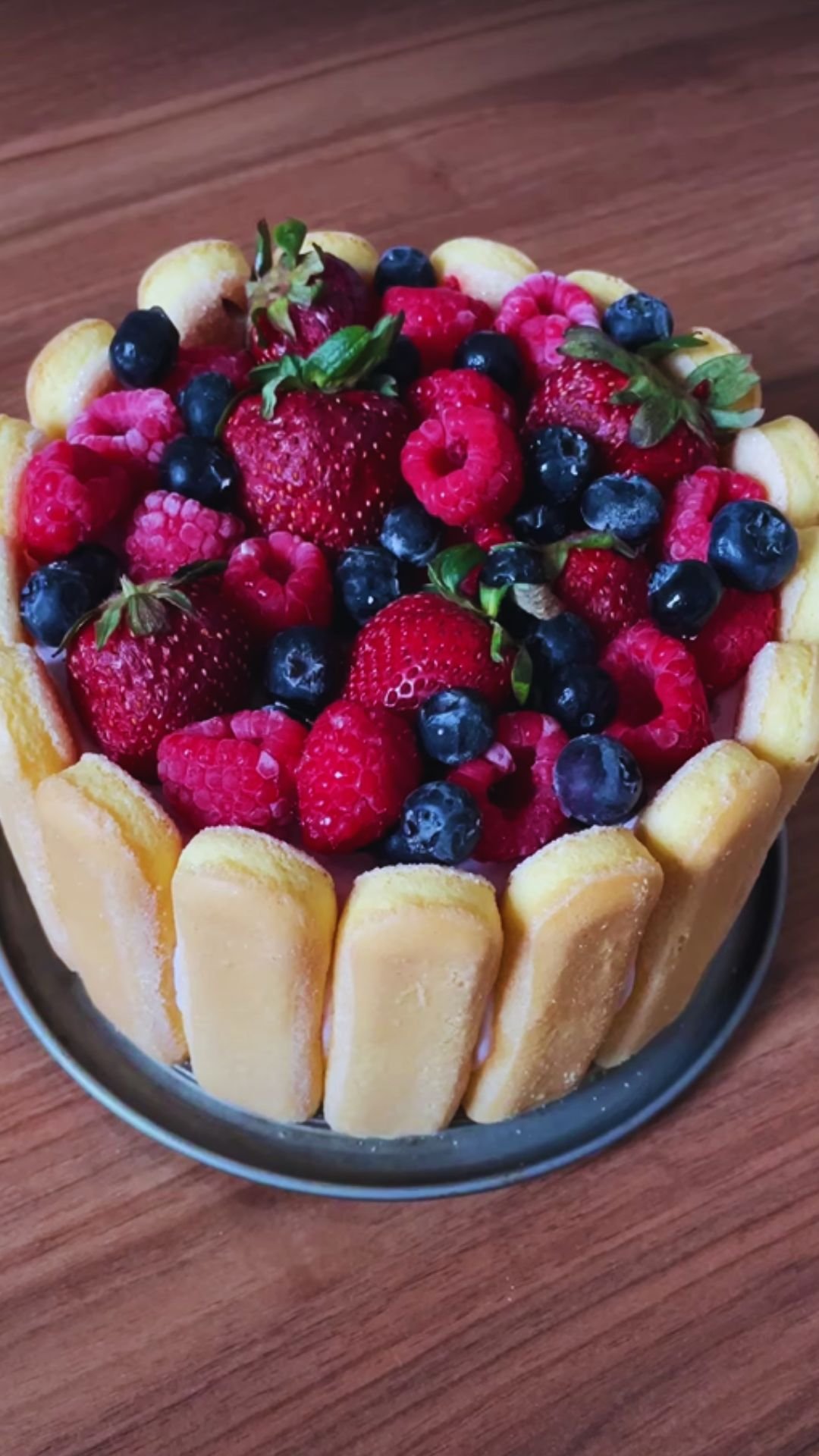There’s something magical about a Charlotte cake that immediately transports me to the finest European patisseries. With its delicate ladyfinger exterior and luscious filling, this dessert has been captivating taste buds for generations. Today, I’m excited to share my foolproof method for creating this classic showstopper in your own kitchen.
As someone who’s been baking Charlotte cakes for over a decade, I’ve perfected the techniques to ensure you achieve a beautiful, delicious result every time. Whether you’re preparing for a special occasion or simply want to challenge yourself with a new baking adventure, I’ll guide you through each step of this remarkable dessert.
What Exactly Is a Charlotte Cake?
A Charlotte cake (also called Charlotte Russe in some traditions) is an elegant molded dessert consisting of ladyfingers arranged around the perimeter of a springform pan, filled with a creamy mousse or bavarian cream. The dessert originated in early 19th century Europe and was named after Queen Charlotte, wife of King George III.
What makes this dessert special is its beautiful presentation and the contrast between the soft, airy filling and the delicate sponge exterior. The traditional filling is often a bavarian cream (a custard set with gelatin and lightened with whipped cream), but modern variations include fruit mousses, chocolate fillings, or layers of different flavors.
Essential Ingredients for the Perfect Charlotte Cake
Before we dive into the process, let’s gather everything we’ll need:
| Component | Ingredients | Quantity | Notes |
|---|---|---|---|
| Ladyfingers | All-purpose flour | 1 cup (125g) | Sifted for better texture |
| Granulated sugar | 3/4 cup (150g) | Divided (1/2 cup for yolks, 1/4 cup for whites) | |
| Eggs | 4 large | Separated | |
| Vanilla extract | 1 tsp | Pure, not imitation | |
| Salt | 1/4 tsp | Fine sea salt preferred | |
| Confectioners’ sugar | 2 tbsp | For dusting | |
| Bavarian Cream | Heavy cream | 2 cups (480ml) | Cold |
| Whole milk | 1 cup (240ml) | Full-fat for richness | |
| Vanilla bean | 1 pod | Or 1 tbsp vanilla extract | |
| Egg yolks | 6 large | Room temperature | |
| Granulated sugar | 2/3 cup (130g) | ||
| Gelatin | 2 tbsp (18g) | Unflavored | |
| Cold water | 1/4 cup (60ml) | For blooming gelatin | |
| Berry Topping | Mixed berries | 2 cups (300g) | Strawberries, raspberries, blueberries |
| Apricot jam | 1/4 cup (80g) | For glaze | |
| Water | 1 tbsp | To thin the glaze | |
| Equipment | Springform pan | 9-inch (23cm) | |
| Parchment paper | For lining | ||
| Electric mixer | Hand or stand mixer | ||
| Pastry brush | For glazing | ||
| Offset spatula | For spreading filling | ||
| Piping bag and tips | Optional for decoration |
Step-by-Step Charlotte Cake Creation
Step 1: Prepare Your Workspace and Equipment
Before I start any complex baking project, I make sure my kitchen is organized. For this Charlotte cake:
- Clear ample counter space for working
- Line the bottom of your springform pan with parchment paper
- Lightly grease the sides of the pan
- Ensure all ingredients are measured and at proper temperature (eggs at room temperature, cream cold)
- Preheat your oven to 350°F (175°C) for the ladyfingers
Step 2: Making the Ladyfingers
While store-bought ladyfingers can work in a pinch, homemade ones provide superior texture and flavor.

- Separate your eggs, placing whites in a clean, grease-free bowl
- Beat egg yolks with 1/2 cup sugar until pale and thick (ribbon stage)
- Fold in vanilla extract
- In another bowl, beat egg whites with salt until foamy
- Gradually add remaining 1/4 cup sugar, beating until stiff peaks form
- Gently fold egg whites into yolk mixture in three additions
- Sift flour over the mixture in batches, folding carefully to maintain volume
- Transfer batter to a piping bag with a 1/2-inch round tip
- Pipe 4-inch strips onto parchment-lined baking sheets, leaving 1-inch between them
- Dust with confectioners’ sugar
- Bake for 12-15 minutes until light golden
- Cool completely on a wire rack
Pro tip: I make extra ladyfingers to ensure I have enough perfect ones for the outside of the cake, plus extras for snacking!
Step 3: Preparing the Bavarian Cream Filling
The heart of any Charlotte cake is its filling. This vanilla bavarian cream is silky, rich, and sets to a perfect consistency.
- In a small bowl, sprinkle gelatin over cold water and let stand for 5 minutes to bloom
- Split vanilla bean lengthwise and scrape seeds (or prepare vanilla extract)
- In a saucepan, combine milk, vanilla bean pod and seeds, and bring to a simmer
- In a separate bowl, whisk egg yolks and sugar until pale yellow
- Slowly pour hot milk into egg mixture, whisking constantly (tempering)
- Return mixture to saucepan and cook over medium-low heat, stirring constantly
- Cook until mixture thickens enough to coat the back of a spoon (175°F/80°C)
- Remove from heat, discard vanilla pod, and stir in bloomed gelatin until dissolved
- Strain through a fine-mesh sieve into a clean bowl
- Allow to cool to room temperature, stirring occasionally (but don’t let it set)
- When mixture is cool but still liquid, whip heavy cream to stiff peaks
- Gently fold whipped cream into custard base in three additions
Key insight: The filling must be cool before folding in whipped cream, but still liquid enough to fold. If it starts to set, gently warm it over a water bath.
Step 4: Assembling the Charlotte Cake
This is where the magic happens! The assembly requires patience but is actually quite straightforward.

- Trim ladyfingers to the height of your springform pan
- Arrange ladyfingers around the inside of the pan, sugar side facing out, standing them upright and placing them snugly side by side
- Cut some ladyfingers to fit the bottom of the pan, creating a base
- When your bavarian cream is ready (still pourable but beginning to set), pour half into the prepared mold
- If adding a fruit layer, arrange a layer of sliced strawberries or other fruit
- Pour in remaining bavarian cream
- Smooth the top with an offset spatula
- Refrigerate for at least 4 hours, ideally overnight, until completely set
Challenge point solved: To ensure ladyfingers stay upright during assembly, I secure them temporarily with a piece of kitchen twine around the outside of the pan, which I remove after the filling has set.
Step 5: Preparing the Berry Topping
The fresh berry topping adds color, flavor, and a professional finish.
- Sort and clean your berries, removing any stems or imperfections
- In a small saucepan, heat apricot jam with water until fluid
- Strain to remove any fruit chunks for a smooth glaze
- Arrange berries on top of the set Charlotte cake in a decorative pattern
- Brush berries with warm apricot glaze for a professional shine
- Return to refrigerator to set the glaze (about 30 minutes)
Step 6: Unmolding and Serving
The moment of truth requires a steady hand but delivers incredible satisfaction!

- Run a thin knife around the edge of the cake to ensure it’s released from the pan
- Release and remove the springform ring
- Gently transfer the cake to a serving plate
- If desired, decorate with additional whipped cream, mint leaves, or a dusting of powdered sugar
- Slice with a sharp knife dipped in hot water between cuts
Flavor Variations for Charlotte Cake
While the classic vanilla bavarian cream is traditional, I love experimenting with different flavors:
| Variation | Filling Adjustment | Decorative Elements | Ladyfinger Adjustment |
|---|---|---|---|
| Chocolate | Add 8 oz melted dark chocolate to bavarian cream | Chocolate shavings, cocoa dusting | Cocoa powder in batter |
| Lemon | Add 2 tbsp lemon zest and 1/4 cup juice | Candied lemon slices | Lemon zest in batter |
| Raspberry | Fold in 1 cup raspberry puree (strained) | Fresh raspberries, pink edible flowers | Standard recipe |
| Coffee | Add 2 tbsp espresso powder | Chocolate-covered coffee beans | Coffee extract in batter |
| Strawberry | Fold in 1 cup strawberry puree | Sliced strawberries in fan pattern | Standard recipe |
| Pistachio | Add 1/2 cup pistachio paste | Chopped pistachios, green fondant decor | Green food coloring |
Troubleshooting Common Charlotte Cake Issues
| Problem | Possible Cause | Solution |
|---|---|---|
| Ladyfingers sliding down | Filling too liquid when poured | Allow filling to thicken slightly before pouring |
| Filling doesn’t set | Insufficient gelatin or overheated gelatin | Ensure proper blooming and don’t overheat; chill longer |
| Ladyfingers too dry | Overbaking | Bake only until light golden; brush with simple syrup if needed |
| Filling leaking through gaps | Ladyfingers not placed tightly enough | Ensure ladyfingers are snug; line with plastic wrap if needed |
| Difficulty unmolding | Insufficient chilling | Chill at least 6 hours, preferably overnight |
| Ladyfingers absorbing too much moisture | Left too long before serving | Assemble no more than 24 hours before serving |
Make-Ahead and Storage Tips
I understand that complex desserts like Charlotte cake benefit from preparation planning:
- Ladyfingers: Can be made up to 5 days ahead, stored in an airtight container
- Filling: Best made just before assembly, but components can be prepped ahead
- Assembled cake: Best made 1 day ahead; store in refrigerator covered loosely with plastic wrap
- Leftovers: Keep refrigerated for up to 3 days; quality diminishes after that
- Freezing: Not recommended as the texture of the bavarian cream will suffer
Serving Suggestions
A Charlotte cake is a statement dessert that needs little embellishment, but here are some serving ideas:
- Accompany with a raspberry or strawberry coulis
- Serve with a small scoop of complementary sorbet
- Add a side of fresh seasonal berries
- Pair with a cup of high-quality coffee or tea
- For special occasions, dust with edible gold powder around the edges
Health and Dietary Adaptations
I believe everyone should be able to enjoy this spectacular dessert:
- Gluten-free: Use gluten-free flour for ladyfingers, being careful with texture
- Dairy-free: Substitute coconut cream for heavy cream and plant-based milk for whole milk
- Lower sugar: Reduce sugar in all components by up to 25% without affecting structure
- Egg-free: More challenging but possible using aquafaba for ladyfingers and agar-agar as setting agent
- Vegan: Combine all above adaptations plus plant-based thickeners for filling
Questions & Answers
What makes a Charlotte cake different from a regular mousse cake? The defining characteristic of a Charlotte cake is the exterior wall of ladyfingers surrounding the filling. While a mousse cake typically has a cake or cookie base with mousse on top, a Charlotte cake is molded with ladyfingers around the sides and sometimes on the bottom, creating a distinct presentation and textural experience.
Can I use store-bought ladyfingers? Absolutely! While homemade ladyfingers provide the best texture and flavor, good-quality store-bought ones are a completely acceptable time-saver. Look for firm, dry ladyfingers (Savoiardi-style) rather than soft, cake-like ones for the best structure.
Why did my bavarian cream curdle? Curdling typically happens when egg yolks are overheated. To prevent this, use a thermometer and never exceed 175°F (80°C), constantly stir the mixture, and immediately remove from heat when it reaches temperature. If it does curdle, you can sometimes rescue it by immediately blending with an immersion blender.
How far in advance can I make this cake? For optimal quality, I recommend making the Charlotte cake no more than 24 hours before serving. The ladyfingers will gradually absorb moisture from the filling, which can be desirable up to a point but will eventually make them too soft.
My gelatin didn’t dissolve properly and left lumps in my filling. What went wrong? Gelatin needs to be properly bloomed (softened in cold liquid) before being dissolved in the warm custard. Additionally, the custard should be warm but not boiling when adding the gelatin. If you encounter lumps, strain the mixture through a fine-mesh sieve before folding in the whipped cream.
Can I make individual mini Charlotte cakes? Yes! Use small ring molds or even large cupcake liners. Cut the ladyfingers to fit the height of your molds and proceed with the same technique. Individual portions make for an impressive presentation at dinner parties.
What can I substitute for gelatin to make this vegetarian? Agar-agar is the best vegetarian substitute for gelatin. Use about 1 tablespoon of agar-agar powder to replace 2 tablespoons of gelatin. Note that agar sets more firmly than gelatin, so you might want to use slightly less for a more delicate texture.
How do I get my ladyfingers to all be the same height? For perfectly even ladyfingers, pipe them using a template under your parchment paper. Alternatively, you can trim them to the same height after baking using a serrated knife once they’ve cooled.
Final Thoughts
Creating a Charlotte cake is truly a labor of love, but the results are undeniably worth it. I find there’s something deeply satisfying about unveiling this classic dessert to appreciative guests, revealing the beautiful pattern of ladyfingers and the perfect slice showing layers of creamy filling.
Don’t be intimidated by the multiple steps—break the process down over a couple of days if needed. The joy of mastering this traditional technique connects you with generations of pastry chefs who have created this same dessert for centuries.
Remember that baking is both science and art. Follow the measurements precisely, but allow your creativity to shine through in the decorative elements and flavor combinations. With practice, you’ll develop the confidence to put your own signature touch on this timeless dessert.
I hope this guide helps you create a Charlotte cake that becomes a treasured recipe in your baking repertoire. Happy baking!


